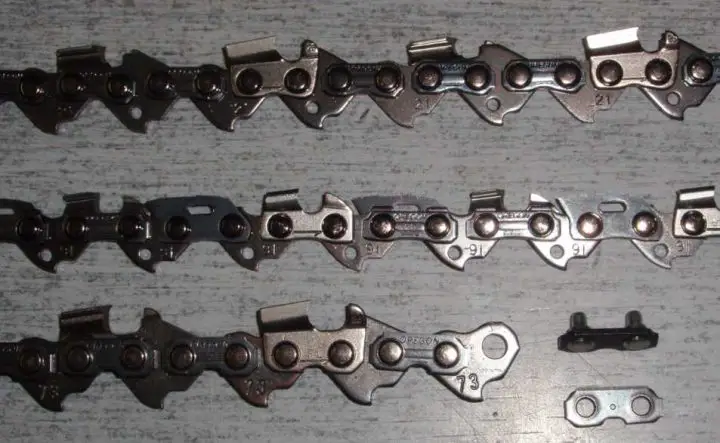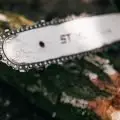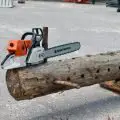Your chainsaw’s chain has numbers stamped on it that have significance. In this article, we’ll clear up some of the confusion around what the numbers on a chainsaw bar and chain mean so that you understand your chainsaw and can find a replacement chain and replacement bar with ease.
We’ll start by addressing the numbers in general before moving on to particular definitions from some of the most well-known chainsaw manufacturers.
Table of Contents
- What Do the Numbers on a Chainsaw Bar Mean?
- What Do the Numbers on a Chainsaw Chain Mean?
- Where to Find Chain Markings
- What Are Gauge and Pitch?
- FAQs (Frequently Asked Questions)

What Do the Numbers on a Chainsaw Bar Mean?
Each chainsaw bar has chain codes/part numbers stamped into the side to provide the user with precise information. It serves as the bar’s part number first and foremost, but it also provides the bar’s parameters.
The letter is intended to provide you with the brand/mount of the chainsaw that this bar was meant to suit. For instance, an “S” stands for the “Stihl” brand. Stihl is unusual in that their bar mounts are exclusively compatible with Stihl brand saws.
However, you could come across an “O” for Oregon, or a “PO” for Poulan, which indicate chainsaw bars manufactured for their own chainsaws and others that use their chainsaw bars. Here are some examples:
| Prefix | Brand/Mount |
| S | Stihl |
| SS | Stihl hard nose bar |
| O | Oregon and others that use their bars |
| HJ, HV | Husqvarna and others that use their bars |
| SHJ, SHV | Husqvarna hard nose bar and others that use their bars |
| PO | Poulan and others that use their bars |
The following two digits, for example, “18,” simply indicate the length of the bar. Therefore, said bar measures 20″. You will find chainsaw bars available in sizes from as low as 8″ and up to 72″.
The chain gauge of the bar is then listed after the bar length. The open distance between the rails, where the chain slides are, is the gauge of the bar. There are four chain gauge sizes: .043, .050, .058, and .063, with the lower sizes being the most prevalent. A chainsaw with the number “50” stamped on the bar denotes a gauge of “.050.”
| Bar Stamping | Bar Gauge |
| 43 | .043” |
| 50 | .050” |
| 58 | .058” |
| 63 | .063” |
The final set of digits indicates the number of the chain’s links in the chainsaw chain that will be used on that specific bar. For a bar that is stamped “72,” this indicates that it requires a 72-drive link chain. Depending on the size of your bar, the number of drive links might range from 28 to 210.
Some bars contain an extra set of numerals in the center that indicate the chain’s pitch. Because they accommodate several manufacturers, these are commonly seen on Husqvarna and Poulan bar mounts. A “38” indicates a 3/8″ pitch. Not all bars will indicate pitch on the stamp.
| Pitch Designation | Pitch |
| 325 | .325” |
| 38 | 3/8” |
Chainsaw Bar Numbers Explainer Video
What Do the Numbers on a Chainsaw Chain Mean?
Look for any number combination stamped on the guide bar. Saw chains and guide bars both feature identification marks that, unless badly worn, describe what pitch and gauge of the chain are on your saw.
Examine the drive links for any numbers or letters. This will frequently inform you what pitch and gauge you’re using. To function properly, the chain must match the guide bar numbers and drive sprocket.
Finally, to determine suitable replacement chains, count the number of drive links on your old chain loop. The drive link count is the last three numbers on the chain part number before the G.
The numbers stamped on a chainsaw chain are an identification code used by the manufacturer to show the chain’s pitch and gauge measures. Pitch and gauge are critical characteristics that determine whether a chain is suitable for a chainsaw.
There are charts in this section that demonstrate the correct gauge and pitch ratings that match to chain marks used by three of the most common chain brands: Carlton, Oregon, Husqvarna, and Stihl.
Carlton Chain Markings
| Chain Marking | Gauge | Pitch |
|---|---|---|
| A1 | .050″ | 3/8″ |
| A2 | .058″ | 3/8″ |
| A3 | .063″ | 3/8″ |
| B1 | .050″ | .404″ |
| B2 | .058″ | .404″ |
| B3 | .063″ | .404″ |
| E1 | .050″ | 1/4″ |
| K1 | .050″ | .325″ |
| K2 | .058″ | .325″ |
| K3 | .063″ | .325″ |
| N1C | .050″ | 3/8″ Low Profile |
| N4 | .043″ | 3/8″ Low Profile |
Husqvarna Chain Markings
| Brand Marking | Gauge | Pitch |
|---|---|---|
| H21 | .058″ | .325″ |
| H22 | .050″ | .325″ |
| H23 | .050″ | .325″ |
| H25 | .058″ | .325″ |
| H26 | .063″ | .325″ |
| H30 | .050″ | .325″ |
| H35 | .050″ | 3/8″ Low Profile |
| H36 | .050″ | 3/8″ Low Profile |
| H42 | .058″ | 3/8″ |
| H45 | .063″ | 3/8″ |
| H46 | .063″ | 3/8″ |
| H47 | .063″ | 3/8″ |
| H57 | .063″ | .404″ |
| H58 | .058″ | 3/8″ |
| H64 | .063″ | .404″ |
| H80 | .050″ | 3/8″ |
| H82 | .050″ | 3/8″ |
| H83 | .050″ | 3/8″ Low Profile |
Oregon Chain Markings
| Brand Marking | Gauge | Pitch |
|---|---|---|
| 11 | .122″ | 3/4″ |
| 16 | .063″ | .404″ |
| 18 | .080″ | .404″ |
| 20 | .050″ | .325″ |
| 22 | .063″ | .325″ |
| 25 | .050″ | 1/4″ |
| 26 | .058″ | .404″ |
| 27 | .063″ | .404″ |
| 28 | .050″ | .404″ |
| 33 | .050″ | .325″ |
| 34 | .058″ | .325″ |
| 35 | .063″ | .325″ |
| 50 | .050″ | .404″ |
| 51 | .058″ | .404″ |
| 52 | .063″ | .404″ |
| 58 | .058″ | .404″ |
| 59 | .063″ | .404″ |
| 68 | .063″ | .404″ |
| 72 | .050″ | 3/8″ |
| 73 | .058″ | 3/8″ |
| 75 | .063″ | 3/8″ |
| 90 | .043″ | 3/8″ Low Profile |
| 91 | .050″ | 3/8″ Low Profile |
| 95 | .050″ | .325″ |
Stihl Chain Markings
| Drive Link Marking | Tooth Link Marking | Gauge | Pitch |
|---|---|---|---|
| 1 | 1 | .043″ | 1/4″ |
| 1 | 3 | .050″ | 1/4″ |
| 3 | 2 | .050″ | .325″ |
| 5 | 2 | .058″ | .325″ |
| 6 | 2 | .063″ | .325″ |
| 3 | 3 | .050″ | 3/8″ |
| 5 | 3 | .058″ | 3/8″ |
| 6 | 3 | .063″ | 3/8″ |
| 1 | 6 | .043″ | 3/8″ Low Profile |
| 3 | 6 | .050″ | 3/8″ Low Profile |
| 3 | 4 | .050″ | .404″ |
| 5 | 4 | .058″ | .404″ |
| 6 | 4 | .063″ | .404″ |
Stihl has a slightly different approach to chain numbers than the other manufacturers mentioned above. Instead of a single chain marking, Stihl employs a two-number combination. One of these numbers is stamped into the drive link (like with other manufacturers), and Stihl also stamps another number into the tooth link.
Where to Find Chain Markings
Don’t worry if all the numbers are making your head spin and you’re not sure where to look for these chain markers. The actual location varies widely depending on the manufacturer, although it’s usually on the drive link. Most manufacturers will include a number as well as the brand name on the drive link.
Stihl is an exception because they utilize a number on the tooth link as well. There are two more ways to measure your chain if you can’t find the chain numbers or can’t read them. Those are covered in our other article here.
What Are Gauge and Pitch?
1. Gauge
The width of the drive links on a chainsaw chain is described by the gauge. The wider the linkages, the greater the gauge. It’s useful to know this because if you’re unsure about a chain’s gauge rating, you can quickly confirm it by measuring the width of the drive link.
When selecting a chainsaw chain, the gauge is crucial since it determines whether or not the chain will fit properly in your chainsaw’s guide bar groove.
The drive links of a chain are the parts of the chain that move around the bar groove, allowing the chain to cling to the chainsaw’s body. If the drive links on your chain are the wrong gauge, they will be either too big or too narrow for the bar groove.
When the gauge is too small, you risk throwing your chain, which can be hazardous. You’d also have trouble maintaining the chain in position, and you might not be able to finish the cut at all.
When the gauge is too large, it will not fit into the bar groove at all. A chain must match the gauge rating of your chainsaw’s bar in order to be compatible with it.
2. Pitch
Technically, the pitch is calculated by dividing the distance between three consecutive rivets by two. In essence, this is a measurement of the distance between the links in your chain. I like to acquire the pitch elsewhere because measuring it manually is a little more difficult. The chain pitch can be determined using the chain marks and the tables above. It’s also usually printed on the packaging (for new chains), so you can sometimes acquire it there.
When shopping for appropriate chains, look at the information stamped on the side of the chainsaw bar to determine the pitch you require for your chainsaw.
3. Drive Link Count
You’ll also need one more piece of information to complete the set of chain measurements: how long the chain should be. Chainsaw chains are not measured in inches or centimeters. Chains are instead measured by the number of links.
For example, instead of saying a chain is 14 inches long, it would say something like “60 links.” If you already have a chain, determining the number of links is simple; simply count them! By the way, this is done through drive links, so make sure those are the ones you’re counting.
The number of links, like gauge and pitch, will impact whether the chain is compatible with your chainsaw. The link count compatible with your chainsaw is stamped into the side of the chainsaw bar. Visit our How to Measure a Chainsaw Bar & Chain Length the RIGHT way guide for more detailed information!
Interested in changing your chainsaw bar? Visit our guides:
- Are Chainsaw Bars Interchangeable? ANSWERED
- Can I Put a Shorter Bar on My Chainsaw? Benefits, & How to GUIDE
- Can I Put a Longer Bar on My Chainsaw? Benefits & How to Guide
FAQs (Frequently Asked Questions)
Can you use a .043 chain on a 050 bar?
No, you should never install .043″ chain on a .050″ bar.
What do the numbers on an OREGON chainsaw bar mean?
Look at the ten-digit number inscribed on the motor end of an OREGON® bar; the first two digits, such as 16, indicate the called length. OREGON® bars may have a different drive link count than other manufacturers.
Can I put a 20-inch bar on a 16-inch chainsaw?
Many chainsaws are designed to accept various size units. The Husqvarna 460 Rancher, for example, is typically marketed with a 20-inch bar and chain. It can, however, take anything between 13″ and 24″. It’s best to check your user’s manual to ensure it is safe to put a different-sized bar on your chainsaw.






Hi I have a bar with these numbers HV205072FP then directly under are these numbers 118 or I18 . What does those three stand for ? Thanks.